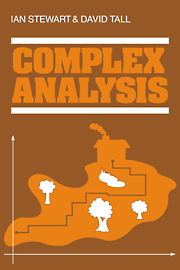Book contents
- Frontmatter
- Contents
- Preface
- Acknowledgement
- 0 The origins of complex analysis, and a modern viewpoint
- 1 Algebra of the complex plane
- 2 Topology of the complex plane
- 3 Power series
- 4 Differentiation
- 5 The exponential function
- 6 Integration
- 7 Angles, logarithms, and the winding number
- 8 Cauchy's Theorem
- 9 Homotopy versions of Cauchy's Theorem
- 10 Taylor series
- 11 Laurent series
- 12 Residues
- 13 Conformal transformations
- 14 Analytic continuation
- Index
- Frontmatter
- Contents
- Preface
- Acknowledgement
- 0 The origins of complex analysis, and a modern viewpoint
- 1 Algebra of the complex plane
- 2 Topology of the complex plane
- 3 Power series
- 4 Differentiation
- 5 The exponential function
- 6 Integration
- 7 Angles, logarithms, and the winding number
- 8 Cauchy's Theorem
- 9 Homotopy versions of Cauchy's Theorem
- 10 Taylor series
- 11 Laurent series
- 12 Residues
- 13 Conformal transformations
- 14 Analytic continuation
- Index
Summary
Students faced with a course on ‘Complex Analysis’ often find it to be just that – complex. In the sense of ‘complicated’.
It is true, of course, that the proofs of some of the major theorems in the subject can demand a certain technical versatility. But in many ways, on a conceptual level, complex analysis is actually easier than real analysis; it just isn't always taught that way.
This book is intended for use at the level of second or third year undergraduates, and it is based on experience accumulated from such courses over the past decade. To exhibit this inherent simplicity of complex analysis we have organized the material around two basic principles: (1) generalize from the real case; (2) when that reveals new phenomena, use the rich geometry of the plane to understand them. Our aim throughout is to encourage geometric thinking, with the proviso that it must be adequately backed up by analytic rigour.
The opening chapter sets the work in its historical context; and the history is often alluded to later as partial motivation. However, we feel that cultural changes often affect the status of conceptual problems: what was once an important difficulty can become a triviality when viewed with hindsight. It is not always necessary to drag today's students through yesterday's hang-ups. We argue the point at greater length below: it is fundamental to our entire approach.
- Type
- Chapter
- Information
- Complex Analysis , pp. ixPublisher: Cambridge University PressPrint publication year: 1983



